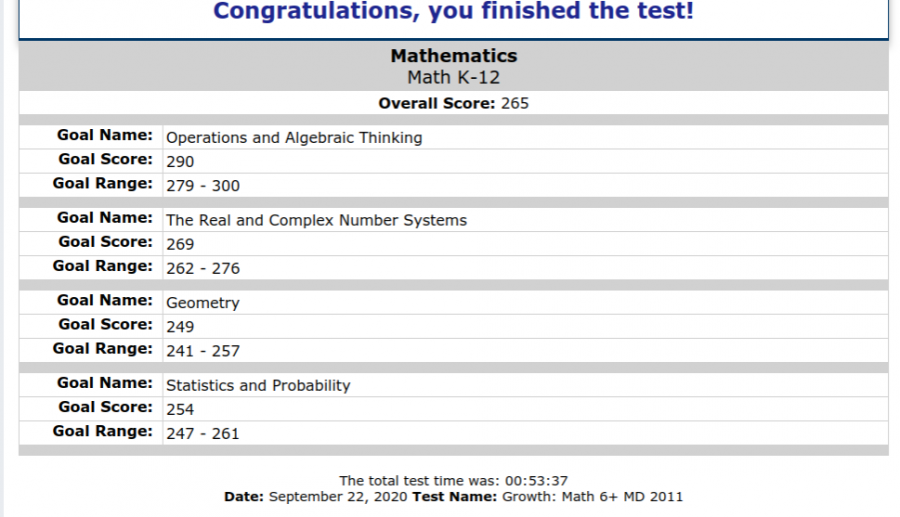MAP testing provides important data that influences virtual learning
When students finished the MAP test, they received a screen that gave them their score. The page included their overall score, as well as the score and range students were in for specific sections.
October 16, 2020
As if sourdough bread making, virtual school, and masks weren’t already enough, COVID-19 has now also added MAP testing to WCHS students’ lives.
The ‘Measures of Academic Progress’ Growth assessment was given to WCHS students in late September as a means to test their growth since school moved online in March. The English and math versions of the test measured how a student did in several key categories to allow teachers to better prepare lessons.
“The diagnostic assessment is designed to inform instruction,” Cheryl Dyson, MCPS area associate superintendent said. “The results from the MAP assessment will be used to monitor each student’s progress throughout the school year. Teachers and school staff will use the assessment results to inform instruction, differentiate learning and measure growth of students.”
The Maryland Department of Education required all school districts to give students a test in the fall, but each district could choose which test their students took. MCPS picked the MAP test for its students, which will be used by teachers to better identify areas where students are struggling.
“MAP is the most appropriate tool because of the data that it provides,” Daniel Miller, WCHS assistant principal said. “This test was in no way to try to benchmark students or fault students for any learning gaps. It really was just an opportunity to provide teachers with appropriate data. Teachers are able to use that information and all of the data it provides to really hone in on appropriate strategies to look at some gaps a student may have.”
Students’ scores will be used to influence what is being taught in virtual learning. Changes will be based on the results, which have not yet been released as students are still taking MAP tests.
“These assessments will be used only as a diagnostic tool in grades 9-12 and should be used to drive instructional planning,” Brena Wolff, Vice President of the Montgomery County Board of Education said. “All schools are expected to analyze MAP assessment data as part of their School Improvement Plan (SIP) process and to use the data to inform their work around school-wide literacy and math goals.”
Jennifer Miller, WCHS English Department Resource Teacher, explained how the test results could be used to help students.
“The scores could be used to help us identify specific students who are struggling and could use reading interventions and supports,” Mrs. Miller said. “We might also be able to look at specific skill bands and determine…where we need greater reteaching or scaffolding for that skill.”
The test, which took place over two days, was conducted entirely online. WCHS administrators administered the test over Zoom and asked students to turn their video cameras on, however not all did. Administrators could also contact students using Zoom’s chat feature.
“I had different screens up,” Inger Swimpson, Ph.D. and WCHS assistant principal said. “I wanted to make sure I was able to manage it and students felt comfortable. Talking to students by name helped alleviate stress.”
However, some students felt awkward or uncomfortable about being watched during the testing sessions.
“Being watched while you work is admittedly a little stressful and awkward,” junior Queen Balina said. “I noticed that many questions were based on the same passages that I received in middle school. Dealing with works that I am familiar with proved to be very helpful.”
According to Wolff, MCPS does not select or approve questions on the test, meaning it is possible that some students received repeat questions. External company NWEA, which creates and manages the test, decided on the questions. Cheating was also discussed by school administrators at county-wide meetings about the testing.
“There was no perfect solution,” Mr. Miller said. “The decision was made to move forward at the county level because the data that it’s going to provide for the teachers outweighed the possibility of a student potentially trying to cheat. We needed to identify those students and see where those learning gaps were.”
Once test results are released, teachers will be able to help students that struggled in specific sections. Balina hopes that MAP testing, even with some of the stress it causes, will be beneficial to students who need help.
“They may be better utilized on an individual basis,” Balina said. “If a teacher notices a student got a low sub-score in one section, they should make sure their student has the help and support that they need.”


